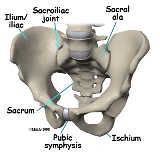What is SI joint Dysfunction?
What does SIJ Dysfunction mean and how does it affect me?
SIJ – stands for the sacro-illiac joint, and is the joint in the pelvis between the sacrum (lowest part of the spine) and the ilium (pelvic bone). There are actually two SI joints, located either side of the sacrum.

There are a number of strong muscles and ligaments that surround the SI joint. The muscles that surround the SI joint don’t actually act directly to produce active movement of the joint as its primary function is to act as shock absorber and transmit forces from the upper body and spine sideways into the pelvis and then into the lower limbs.
Causes of SIJ Dysfunction:
Alteration in the normal motion of the SI joint will result in pain. This can be too much movement (hyper-mobility) and too little movement (hypo-mobility). People that have suffered from SI joint dysfunction know how excruciating it can be and how it can manifest itself in the low back, the hip, and even down the leg. It can make simple daily activities such as getting in and out of a car; turning over in bed; standing up from a sitting position difficult and troublesome.
A common example of SI joint hyper-mobility is during pregnancy as the muscle and ligamentous structures stabilising the joint get affected due to altered hormone levels. The hormones released during pregnancy relax the ligaments of the body to allow the pelvis to enlarge, in preparation for childbirth. Due to the growing uterus, some of the core muscles around the pelvis get ‘stretched’ and weakened. The additional weight gain and altered gait lead to an increased mechanical strain on the SI joints which may cause pain over the joint and can manifest itself as low back pain, hip pain or even sciatica.
Hypo-mobility can result from direct trauma to the joint, such as a fall onto the buttocks, motor vehicle accident or even as simple as missing step when walking downstairs.
Abnormal movement from sports can directly injure the SI joints by stretching/straining the SI ligaments.
An interesting study undertaken by Dr Stuart McGill looked at the forces transmitted to the SIJ during a 27kg squat. He found the total force transmitted to this SI joint during this activity was 6.5 kN – which is surprisingly enough to lift a small car off of the ground! No wonder SI dysfunction can lead to significant pain…
Our Osteopaths treat this condition by working on the soft-tissue and ligamentous structures around this joint, along with joint mobilisation and manipulation. This can often give immediate relief. We would also work on optimizing your posture and working on your core and hip stability. Appropriate self management advice would also be given.
If you would like further information about SI Joint Dysfunction or if you think you might suffer from this condition, please do not hesitate to contact our clinic and speak to one of our Osteopaths:
Osteopathy & Podiatry Centre
583 Orchard Rd
#06-03 Forum (office block)
Singapore 238884
Telephone: 6734 4236
Email: info@osteopathy-podiatry.com
Web site:www.osteopathy-podiatry.com

